本文概述
堆排序是基于二叉堆数据结构的基于比较的排序技术。它类似于选择排序, 在这里我们首先找到最大元素, 然后将最大元素放在最后。我们对其余元素重复相同的过程。
什么是二叉堆??
让我们首先定义一个完整的二叉树。完整的二叉树是一个二叉树, 其中除最后一个级别外, 每个级别都已完全填充, 并且所有节点都尽可能地靠左(来源维基百科:http://en.wikipedia.org/wiki/Binary_tree#Types_of_binary_trees)
一种二叉堆是一个完整的二叉树, 其中项以特殊顺序存储, 使得父节点中的值大于(或小于)其两个子节点中的值。前者称为最大堆, 后者称为最小堆。堆可以由二叉树或数组表示。
为什么要基于数组表示二叉堆?
由于Binary Heap是完整的Binary Tree, 因此可以很容易地将其表示为数组, 并且基于数组的表示节省空间。如果父节点存储在索引I处, 则可以通过2 * I + 1来计算左子节点, 通过2 * I + 2来计算右子节点(假设索引从0开始)。
用于按升序排序的堆排序算法:
1. 根据输入数据构建最大堆。
2. 此时, 最大的项目存储在堆的根目录中。将其替换为堆的最后一项, 然后将堆的大小减小1。最后, 堆放树的根。
3. 堆大小大于1时, 请重复步骤2。
如何构建堆?
只有在堆满了其子节点后, 堆过程才能应用于该节点。因此, 必须按自下而上的顺序执行堆化。
让我们借助示例来理解:
Input data: 4, 10, 3, 5, 1
4(0)
/ \
10(1) 3(2)
/ \
5(3) 1(4)
The numbers in bracket represent the indices in the array
representation of data.
Applying heapify procedure to index 1:
4(0)
/ \
10(1) 3(2)
/ \
5(3) 1(4)
Applying heapify procedure to index 0:
10(0)
/ \
5(1) 3(2)
/ \
4(3) 1(4)
The heapify procedure calls itself recursively to build heap
in top down manner.C++
// C++ program for implementation of Heap Sort
#include <iostream>
using namespace std;
// To heapify a subtree rooted with node i which is
// an index in arr[]. n is size of heap
void heapify( int arr[], int n, int i)
{
int largest = i; // Initialize largest as root
int l = 2*i + 1; // left = 2*i + 1
int r = 2*i + 2; // right = 2*i + 2
// If left child is larger than root
if (l < n && arr[l] > arr[largest])
largest = l;
// If right child is larger than largest so far
if (r < n && arr[r] > arr[largest])
largest = r;
// If largest is not root
if (largest != i)
{
swap(arr[i], arr[largest]);
// Recursively heapify the affected sub-tree
heapify(arr, n, largest);
}
}
// main function to do heap sort
void heapSort( int arr[], int n)
{
// Build heap (rearrange array)
for ( int i = n / 2 - 1; i >= 0; i--)
heapify(arr, n, i);
// One by one extract an element from heap
for ( int i=n-1; i>0; i--)
{
// Move current root to end
swap(arr[0], arr[i]);
// call max heapify on the reduced heap
heapify(arr, i, 0);
}
}
/* A utility function to print array of size n */
void printArray( int arr[], int n)
{
for ( int i=0; i<n; ++i)
cout << arr[i] << " " ;
cout << "\n" ;
}
// Driver program
int main()
{
int arr[] = {12, 11, 13, 5, 6, 7};
int n = sizeof (arr)/ sizeof (arr[0]);
heapSort(arr, n);
cout << "Sorted array is \n" ;
printArray(arr, n);
}Java
// Java program for implementation of Heap Sort
public class HeapSort
{
public void sort( int arr[])
{
int n = arr.length;
// Build heap (rearrange array)
for ( int i = n / 2 - 1 ; i >= 0 ; i--)
heapify(arr, n, i);
// One by one extract an element from heap
for ( int i=n- 1 ; i> 0 ; i--)
{
// Move current root to end
int temp = arr[ 0 ];
arr[ 0 ] = arr[i];
arr[i] = temp;
// call max heapify on the reduced heap
heapify(arr, i, 0 );
}
}
// To heapify a subtree rooted with node i which is
// an index in arr[]. n is size of heap
void heapify( int arr[], int n, int i)
{
int largest = i; // Initialize largest as root
int l = 2 *i + 1 ; // left = 2*i + 1
int r = 2 *i + 2 ; // right = 2*i + 2
// If left child is larger than root
if (l < n && arr[l] > arr[largest])
largest = l;
// If right child is larger than largest so far
if (r < n && arr[r] > arr[largest])
largest = r;
// If largest is not root
if (largest != i)
{
int swap = arr[i];
arr[i] = arr[largest];
arr[largest] = swap;
// Recursively heapify the affected sub-tree
heapify(arr, n, largest);
}
}
/* A utility function to print array of size n */
static void printArray( int arr[])
{
int n = arr.length;
for ( int i= 0 ; i<n; ++i)
System.out.print(arr[i]+ " " );
System.out.println();
}
// Driver program
public static void main(String args[])
{
int arr[] = { 12 , 11 , 13 , 5 , 6 , 7 };
int n = arr.length;
HeapSort ob = new HeapSort();
ob.sort(arr);
System.out.println( "Sorted array is" );
printArray(arr);
}
}python
# Python program for implementation of heap Sort
# To heapify subtree rooted at index i.
# n is size of heap
def heapify(arr, n, i):
largest = i # Initialize largest as root
l = 2 * i + 1 # left = 2*i + 1
r = 2 * i + 2 # right = 2*i + 2
# See if left child of root exists and is
# greater than root
if l < n and arr[i] < arr[l]:
largest = l
# See if right child of root exists and is
# greater than root
if r < n and arr[largest] < arr[r]:
largest = r
# Change root, if needed
if largest ! = i:
arr[i], arr[largest] = arr[largest], arr[i] # swap
# Heapify the root.
heapify(arr, n, largest)
# The main function to sort an array of given size
def heapSort(arr):
n = len (arr)
# Build a maxheap.
for i in range (n / / 2 - 1 , - 1 , - 1 ):
heapify(arr, n, i)
# One by one extract elements
for i in range (n - 1 , 0 , - 1 ):
arr[i], arr[ 0 ] = arr[ 0 ], arr[i] # swap
heapify(arr, i, 0 )
# Driver code to test above
arr = [ 12 , 11 , 13 , 5 , 6 , 7 ]
heapSort(arr)
n = len (arr)
print ( "Sorted array is" )
for i in range (n):
print ( "%d" % arr[i]), # This code is contributed by Mohit KumraC#
// C# program for implementation of Heap Sort
using System;
public class HeapSort
{
public void sort( int [] arr)
{
int n = arr.Length;
// Build heap (rearrange array)
for ( int i = n / 2 - 1; i >= 0; i--)
heapify(arr, n, i);
// One by one extract an element from heap
for ( int i=n-1; i>0; i--)
{
// Move current root to end
int temp = arr[0];
arr[0] = arr[i];
arr[i] = temp;
// call max heapify on the reduced heap
heapify(arr, i, 0);
}
}
// To heapify a subtree rooted with node i which is
// an index in arr[]. n is size of heap
void heapify( int [] arr, int n, int i)
{
int largest = i; // Initialize largest as root
int l = 2*i + 1; // left = 2*i + 1
int r = 2*i + 2; // right = 2*i + 2
// If left child is larger than root
if (l < n && arr[l] > arr[largest])
largest = l;
// If right child is larger than largest so far
if (r < n && arr[r] > arr[largest])
largest = r;
// If largest is not root
if (largest != i)
{
int swap = arr[i];
arr[i] = arr[largest];
arr[largest] = swap;
// Recursively heapify the affected sub-tree
heapify(arr, n, largest);
}
}
/* A utility function to print array of size n */
static void printArray( int [] arr)
{
int n = arr.Length;
for ( int i=0; i<n; ++i)
Console.Write(arr[i]+ " " );
Console.Read();
}
// Driver program
public static void Main()
{
int [] arr = {12, 11, 13, 5, 6, 7};
int n = arr.Length;
HeapSort ob = new HeapSort();
ob.sort(arr);
Console.WriteLine( "Sorted array is" );
printArray(arr);
}
}
// This code is contributed
// by Akanksha Rai(Abby_akku)PHP
<?php
// Php program for implementation of Heap Sort
// To heapify a subtree rooted with node i which is
// an index in arr[]. n is size of heap
function heapify(& $arr , $n , $i )
{
$largest = $i ; // Initialize largest as root
$l = 2* $i + 1; // left = 2*i + 1
$r = 2* $i + 2; // right = 2*i + 2
// If left child is larger than root
if ( $l < $n && $arr [ $l ] > $arr [ $largest ])
$largest = $l ;
// If right child is larger than largest so far
if ( $r < $n && $arr [ $r ] > $arr [ $largest ])
$largest = $r ;
// If largest is not root
if ( $largest != $i )
{
$swap = $arr [ $i ];
$arr [ $i ] = $arr [ $largest ];
$arr [ $largest ] = $swap ;
// Recursively heapify the affected sub-tree
heapify( $arr , $n , $largest );
}
}
// main function to do heap sort
function heapSort(& $arr , $n )
{
// Build heap (rearrange array)
for ( $i = $n / 2 - 1; $i >= 0; $i --)
heapify( $arr , $n , $i );
// One by one extract an element from heap
for ( $i = $n -1; $i > 0; $i --)
{
// Move current root to end
$temp = $arr [0];
$arr [0] = $arr [ $i ];
$arr [ $i ] = $temp ;
// call max heapify on the reduced heap
heapify( $arr , $i , 0);
}
}
/* A utility function to print array of size n */
function printArray(& $arr , $n )
{
for ( $i = 0; $i < $n ; ++ $i )
echo ( $arr [ $i ]. " " ) ;
}
// Driver program
$arr = array (12, 11, 13, 5, 6, 7);
$n = sizeof( $arr )/sizeof( $arr [0]);
heapSort( $arr , $n );
echo 'Sorted array is ' . "\n" ;
printArray( $arr , $n );
// This code is contributed by Shivi_Aggarwal
?>输出如下:
Sorted array is
5 6 7 11 12 13这里是以前的C代码供参考。
注意:
堆排序是一种就地算法。
它的典型实现方式不稳定, 但是可以使其稳定(参考lsin这篇文章)
时间复杂度:heapify的时间复杂度为O(Logn)。 createAndBuildHeap()的时间复杂度为O(n), 堆排序的整体时间复杂度为O(nLogn)。
HeapSort的应用
1.对几乎排序(或K排序)的数组进行排序
2.数组中的k个最大(或最小)元素
堆排序算法的用途有限, 因为Quicksort和Mergesort在实践中更好。但是, 堆数据结构本身已被大量使用。看到堆数据结构的应用
堆排序图解:
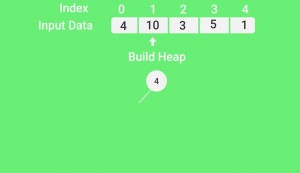
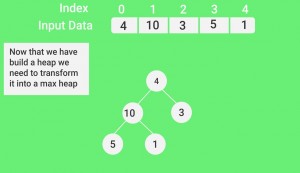
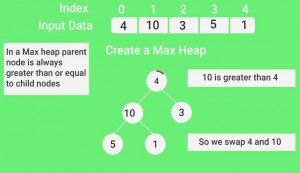
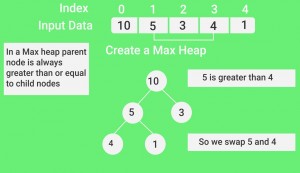
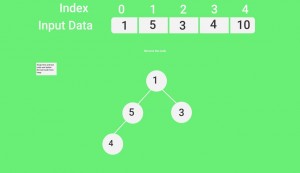
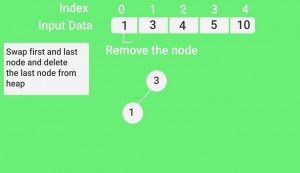
如果发现任何不正确的地方, 或者想分享有关上述主题的更多信息, 请写评论。

![从字法上最小长度N的排列,使得对于正好为K个索引,a[i] a[i]+1](https://www.lsbin.com/wp-content/themes/begin%20lts/img/loading.png)